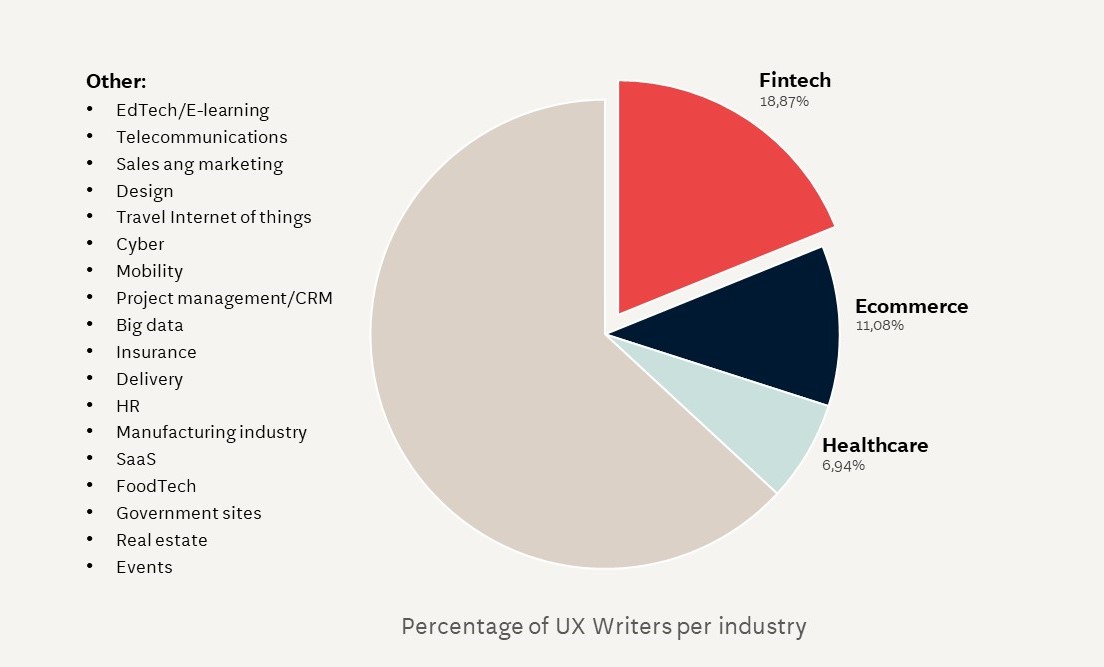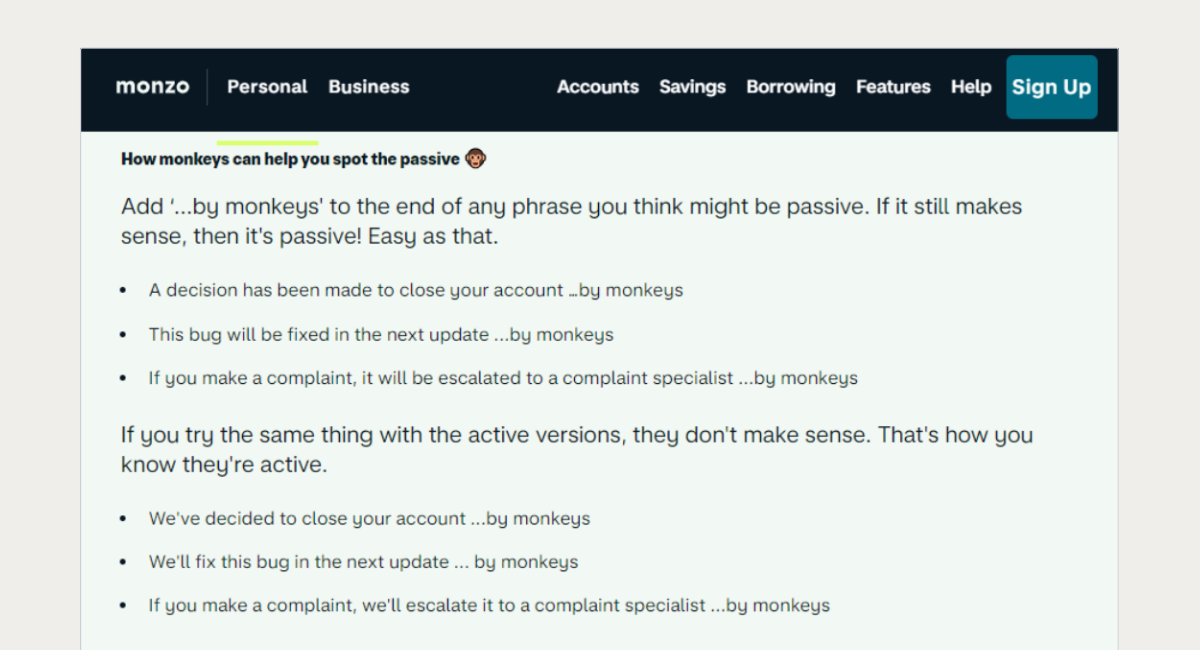UX writing has taken the world of product design by storm. Banks and fintech are two examples of industry sectors that have everything to win by paying attention to the words that communicate their digital products. We’ll explain why and how to get started.
What is UX writing?
Shortly put, you could say that UX writing (also known as content design and product writing) is the practice to design the words used on websites and in digital products.
UX design established itself as a given part of product design many moons ago. More recently, the spotlight shifted to an often-forgotten part of interfaces: the words. At some point, people started to realise that it helps to have someone in charge for communicating digital products clearly and consistently. This is a smart idea for several reasons:
- In digital products, users are guided by words
- The words drive users to take action
- Action is often directly related to conversion rates
One part of the job is to research, create and test microcopy – those little snippets of text that guide users through interfaces. A few examples of microcopy are headings, introductions, CTA buttons and links, tooltips, notifications and error messages.
Another aspect of UX writing is to make sure that a company’s tone of voice is consistent throughout the whole customer journey. As the words are an integral part of the design, the text should be designed with the rest of the product. To do a decent job, UX writers need to be familiar with the company, the product, the project, the goals, the target groups and the brand voice. The more context they have, the better.
The most important thing to note is that a UX writer should be an active member of the design team. This means that you should include them in the process as early as possible – yes, invite them to those initial planning meetings!
The goals and benefits of UX writing
As with UX in general, the goal of UX writing is to make the user experience as simple and friction-free as possible. UX writers focus on the words, but their contribution to the user experience cake is more than the icing on the top.
This is highly relevant for financial products. Unclear error messages, for example, may cause worry or even panic as banking apps handle people’s hard-earned money. While language is far from the only thing that needs to work seamlessly, it can have a significant effect on many levels:
Higher conversion rates
If improving the user experience is one side of the UX coin, the other is related to business goals. The idea is that by removing friction, you can also increase conversion rates.
Without text in digital products, users would get lost. If users don’t find their way, they will not convert. Plus, they might leave your product feeling annoyed or even furious – nobody likes to waste time with technology.
The ultimate goal is to hit the sweet spot where a good user experience meets business goals.
Reducing calls to customer support
A positive side effect of clear and simple digital products is that users can complete their tasks without the need for support. If they don’t get stuck, they won’t need to call customer support. And I think it’s safe to assume that most people don’t look forward to a phone call with their bank’s support team.
This is also great news for the banks. Fewer support calls means less stress for support staff, allowing them to provide better service.
Building trust
Besides conversion rates and fewer support calls, there’s another important aspect of UX writing: Building trust. There are two ways to do this:
- Aligning the language used with the company’s brand voice. This means that users get a coherent experience across platforms and products.
- Using language that resonates with the target group(s), which helps users understand the product and make them feel at home.
To ensure a consistent brand voice, UX writers need to familiarise themselves with the company and product goals. They need access to the company style guide or other branding documents. If there is no content style guide, they can help creating one.
As for point 2, the best way is for UX writers to consult or carry out UX content research. Once it’s clear how the target groups communicate, they can use language that they can relate to.
The idea is that UX writers should not rely only on their own experience and general best practices.
The specific challenges of financial products
Today, banks and other financial institutions employ large numbers of UX writers. In UX Writing Hub’s 2022 salary survey, almost 19% of the UX writers who completed the survey work in fintech – way ahead of ecommerce (11%) and health (just under 7%). Let’s think about this for a bit. Why do banks and fintech companies employ so many UX writers?

Difficult financial concepts and terms
The world of finance is full of financial jargon and acronyms that only banking staff are familiar with.
Research carried out by Nielsen Norman Group shows that people read (or scan, rather) 25% slower online. Complex language will slow down the user experience even further.
We’ve also seen a general shift towards more conversational copy in online experiences. While “plain English” is far from new, this concept is evolving into written language that is getting closer and closer to spoken language. These days, nobody wants to sound like a bank – not even banks themselves.
An important part of UX writing for banks and fintech is to work on explaining the features and clarifying the flows from the users’ point of view.
Complex products and flows
Banking digital products often have many long and complex flows. The user journeys need high-level security and vary depending on numerous factors that may have to be verified (income, expenses and spending habits, etc.)
Users who get stuck with their banking app have to get in touch with the bank. In many banks, the waiting time is frustratingly long, causing friction both for users and for the bank.
The ultimate goal of UX is to make products so intuitive that no instructions, tutorial videos or customer support calls are needed. Clarity is also a way to increase trust. If users are faced with text they don’t understand, they may get suspicious, and rightly so.
Communicating with empathy
Financial markets are sensitive to global changes and trends, and these changes can have a huge knock-on effect on people’s lives. Events such as Brexit, covid restrictions, the war in Ukraine and the current cost of living crisis impact businesses of all sizes. As such, it’s so important for financial products to communicate with empathy. This is easier said than done.
A recent example of empathy gone wrong is when a British energy provider offered their top 10 tips to keep warm. The list included things like doing star jumps and cuddling your pet. It was meant to be helpful although many of their customers just found the advice condescending.
Even if we manage to avoid this kind of blunder, how can we be sure our words hit the right spot? Companies that make an effort with UX develop an iterative process that includes research and testing.
Challenger banks leading the way
In the last 10-or-so years, long-established UK banks like Barclays and HSBC have been challenged by new alternatives like Monzo and Starling. The same thing is happening in many other countries.

One thing these challenger banks tend to have in common is the way they communicate. Monzo made their style guide publicly available, and therefore we know that they took a conscious decision to use plain English.
“We use the language our audience uses, and make technical stuff as clear as we can”, “We’re transparent about what we’re doing and why, and we don’t hide behind ambiguity” [1]
With statements like this included in the style guide, UX writers have company-wide support to make sure all copy is as easy to understand as possible.
This trend is reflected outside the world of fintech too. Leading brands like Slack and Headspace pioneer the quest for understandable copy. Their efforts span across the customer experience to include legal copy like terms and conditions and technical details like release notes.
Traditional banks and legacy copy
Unlike these newer brands, traditional banks have massive amounts of legacy copy already embedded in their products, websites, and email templates. This copy has been hanging around for many years, most likely long before anyone had ever put the words “UX” and “writer” together. Bringing such legacy copy up to date is a major effort that requires big teams of competent writers.
A broad target audience
While some finance products target specific age groups or locations, most banks are open to everyone. Just like writers who work in public institutions or within health, fintech writers need to use accessible language. In other words, our product texts should be easily understood by everyone regardless of age, education or language fluency.
Surveys indicate that 16.4% of adults in England have “very poor literacy skills”. This means that they can follow short, simple texts but will struggle to understand unfamiliar topics. The UK government recommends that public text should aim for a reading level that can be understood by 9-year-olds (many other public-facing companies have similar guidelines, including Netflix!).
Banks would be wise to do the same. Besides the general literacy level, it’s safe to assume that 100% of the population prefers to spend as little time as possible managing their bank details 😊
Luckily there are plenty of tools that indicate the reading level of texts, for example the free Hemingway Editor app.
The UX writing process
So what does the UX writing process look like? How do you get started and when should you involve a UX writer?
How to get started
If you’ve never had a UX writer on the team, there’s some groundwork to be done.
First of all, the UX writer has to familiarise themselves with the company, the product and the projects they’ll be involved with. This includes talking to a lot of people and gathering useful information.
Exactly what needs to be done depends on which stage the company is in. Perhaps there are some branding documents, a design style guide or design system, a company mission and vision, competitor analysis, target group research or personas in place. Any of these will help the UX writer understand how to communicate the product.
If you don’t have any of these documents, you may want to consider creating at least some of them (you don’t have to do everything at once, of course 😊).
Content style guide and tone of voice
What about a content style guide and tone of voice (often called “voice and tone” among UX writers), are these necessary resources for a UX writer? It depends on who you ask. My opinion is that they can be incredibly useful, especially if there’s a team of writers working on the same product.
The question is how to create a style guide that can be used by anyone, not just the writers on the team. The optimal way is to incorporate the content style guide with the design system, so that any UX copy advice is readily available in the systems designers are used to. This is already happening in many places – you can read more about it in the article All you need to know about content design systems.
Another cool trend is to use an AI-based tool like writer.com. It allows companies to feed their style guide into their content systems. In other words, everyone gets style guide advice on the go – like a personalised Grammarly.
UX writing strategy
Another important thing to remember: UX writing is a strategic kind of writing. This means that we shouldn’t just rewrite copy for the sake of rewriting copy. Instead we should use data, customer feedback and research insights to identify pain points, try different copy solutions to refine those pain points, and test our revisions with users.
For example, if data shows that only 40% of users complete the onboarding process, a company may want to increase that number. Statistics can shed light on where in the journey users drop out. A UX designer and UX writer can then work together and come up with suggestions to improve the data.
Who should be involved and when?
Designers
To get the most out of a UX writer, be sure to involve them when you involve a UX designer. The designer and writer will work together to create flows that minimise friction and lead users toward their goals as smoothly as possible.
If you fill your screens with lorem ipsum, there’s a high risk that you’ll get some nasty surprises at the end - the copy needed will probably not fit in the dedicated boxes. When these issues are highlighted early in the process, you’ll likely save a lot of time, sweat and tears later.
Developers
UX writers also liaise with developers around error messages and system notifications. The UX writer makes sure these messages are clear, easy to understand and in line with the product’s voice and tone.
Customer support
We’ve already mentioned that UX writing has the potential of reducing customer service calls. To make this a reality, UX writers and customer support need to communicate. Together they can identify and improve user pain points.
The legal team
Another important stakeholder is the legal representative. Common legal texts like cookie messages, T&Cs and privacy policies are often unnecessarily complicated. A skilled UX writer can turn it into plain English so that customers understand what they’re signing up for. Magic :) Just be aware that there may be some resistance from the legal team, who are used to writing in a very specific way. Support from higher management goes a long way to making this happen.
Product owners, project managers, higher management
Most product teams have an approval process in place. Designs and copy are usually signed off by a product owner, project manager and/or higher management.
Best practices (research, testing)
UX writers use similar methods to UX designers, but with a different focus. They conduct UX research (or consult existing research or collaborate with UX researchers), including user interviews and usability testing. They also make use of content-specific research methods such as conversation mining and highlighter testing.
Summary
UX writing is a new-ish design discipline focusing on the words in digital products. While it has the potential of improving any digital experience, it’s already becoming standard practice within banking and fintech. These industry sectors show what design teams may gain by including UX writers. From dealing with financial jargon to communicating with empathy, a strategic approach to product copy can be a great way to identify and rectify user pain points and increase conversion rates.
[1] https://monzo.com/tone-of-voice
Author

Anja Wedberg
Senior Content Editor
Anja is a Senior Content Editor with a background in translation, marketing and web publishing. She spends most of her spare time fighting, either with new karate moves or with Polish consonant clusters. Check out the rest of her blog articles at medium.com/anja.
Related articles
![A well-crafted prompt doesn’t just work once. It works across teams, channels, and campaigns. It can be tweaked for new use cases and refined based on what performs best.]()
June 27, 2025 / 4 min read
Prompts are not just for AI. Why building a prompt library pays off
Prompts aren’t throwaway lines. They’re repeatable, scalable assets that can streamline your marketing your team’s output. Learn how to build a prompt library that delivers.
![Woman using a wheelchair in the office settings]()
June 17, 2025 / 5 min read
What is accessibility and why it matters?
Accessibility ensures everyone — including those with disabilities or limitations — can read, navigate, and engage with your content equally.



